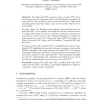Free Online Productivity Tools
i2Speak
i2Symbol
i2OCR
iTex2Img
iWeb2Print
iWeb2Shot
i2Type
iPdf2Split
iPdf2Merge
i2Bopomofo
i2Arabic
i2Style
i2Image
i2PDF
iLatex2Rtf
Sci2ools
62
Voted
AAECC
2007
Springer
2007
Springer
The Tangent FFT
The split-radix FFT computes a size-n complex DFT, when n is a large power of 2, using just 4n lg n−6n+8 arithmetic operations on real numbers. This operation count was first announced in 1968, stood unchallenged for more than thirty years, and was widely believed to be best possible. Recently James Van Buskirk posted software demonstrating that the split-radix FFT is not optimal. Van Buskirk’s software computes a sizen complex DFT using only (34/9 + o(1))n lg n arithmetic operations on real numbers. There are now three papers attempting to explain the improvement from 4 to 34/9: Johnson and Frigo, IEEE Transactions on Signal Processing, 2007; Lundy and Van Buskirk, Computing, 2007; and this paper. This paper presents the “tangent FFT,” a straightforward in-place cachefriendly DFT algorithm having exactly the same operation counts as Van Buskirk’s algorithm. This paper expresses the tangent FFT as a sequence of standard polynomial operations, and pinpoints how the tangent FF...
| Added | 06 Jun 2010 |
| Updated | 06 Jun 2010 |
| Type | Conference |
| Year | 2007 |
| Where | AAECC |
| Authors | Daniel J. Bernstein |
Comments (0)

